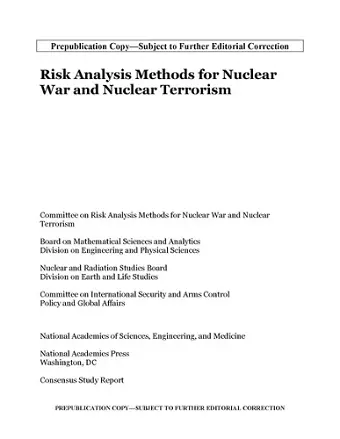Risk Analysis Methods for Nuclear War and Nuclear Terrorism
Division on Earth and Life Studies author Division on Engineering and Physical Sciences author Policy and Global Affairs author Nuclear and Radiation Studies Board author Committee on International Security and Arms Control author National Academies of Sciences, Engineering, and Medicine author Board on Mathematical Sciences and Analytics author Committee on Risk Analysis Methods for Nuclear War and Nuclear Terrorism author
Format:Paperback
Publisher:National Academies Press
Published:15th Oct '23
Currently unavailable, and unfortunately no date known when it will be back

The assessment of risk is complex and often controversial. It is derived from the existence of a hazard, and it is characterized by the uncertainty of possible undesirable events and their outcomes. Few outcomes are as undesirable as nuclear war and nuclear terrorism. Over the decades, much has been written about particular situations, policies, and weapons that might affect the risks of nuclear war and nuclear terrorism. The nature of the concerns and the risk analysis methods used to evaluate them have evolved considerably over time.
At the request of the Department of Defense, Risk Analysis Methods for Nuclear War and Nuclear Terrorism discusses risks, explores the risk assessment literature, highlights the strengths and weaknesses of risk assessment approaches, and discusses some publicly available assumptions that underpin U.S. security strategies, all in the context of nuclear war and nuclear terrorism.
Table of Contents- Front Matter
- Summary
- 1 Introduction
- 2 The Threat of Nuclear War and Nuclear Terrorism: Classes of Scenarios
- 3 The History and Literature of Risk Assessment for Nuclear War and Nuclear Terrorism
- 4 The Use of Risk Assessment for Nuclear War and Nuclear Terrorism
- 5 The Structure of Risk Analysis
- 6 Risk Analysis Methods and Models
- 7 Risk Information and Risk Management Decisions
- 8 Conclusions and Next Steps
- References
- Appendixes
- Appendix A: U.S. Strategic Assumptions About Nuclear Risks
- Appendix B: Types of Uncertainty
- Appendix C: U.S. Policy-Making Structure for Nuclear War and Nuclear Terrorism
- Appendix D: Agendas of Committee Meetings
- Appendix E: Committee Member Biographies <
ISBN: 9780309689984
Dimensions: unknown
Weight: unknown
170 pages